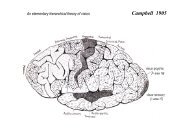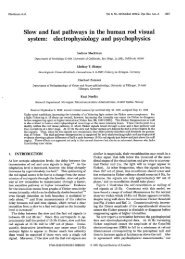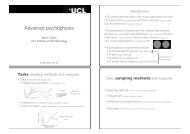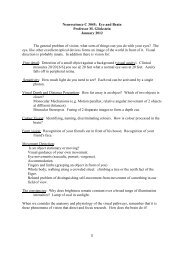Fundamentals of neuroscience: cells, axons, and synapses
Fundamentals of neuroscience: cells, axons, and synapses
Fundamentals of neuroscience: cells, axons, and synapses
You also want an ePaper? Increase the reach of your titles
YUMPU automatically turns print PDFs into web optimized ePapers that Google loves.
Nernst EquationRTE K =__ZFWhereln____ [K + ] o[K + ] iE K = K + Equilibrium Pot’l.R = Gas ConstantT = Absolute TemperatureZ = Valence <strong>of</strong> K +F = Faraday Constant[K + ] o,i =K + concentrationsSubstituting,E K = 26mVNerve___ 20ln400 = -75mVRelationship <strong>of</strong> Membrane Potential (V m ) to [K + ] o0V m25mV5075100Nernst1 10 [K + ] 100o mM1. How can concentration gradients forNa + , K + , <strong>and</strong> Cl - all be maintainedacross the cell membrane?2. How do these gradients interact todetermine the resting membranepotential?IonDistribution <strong>of</strong> Major Ions Across theMembrane <strong>of</strong> the Squid Giant AxonCytoplasmExtracellularFluidNernstPotentialPassive <strong>and</strong> Active Movement <strong>of</strong> Ions through the MembraneMembraneIntracellularK + K +E K - V m = -10mVExtracellularK + 400 20-75Cl - 52 560 -60Na + 50 440 +55(mM) (mM) (mV)MetabolicEnergy(ATP)Na +Na + -K +PumpK +Na +Resting Pot’l (V m ) = -75mVE Na - V m = 155mVResting potential ca. -60mVGOLDMAN EQUATIONV m =RT __FlnIf P K>> P Na<strong>and</strong> P Cl,_______________________P K[K + ] o+ P Na[Na + ] o + P Cl[Cl - ] iP K[K + ] + iP Na[Na + ] i+ P Cl[Cl - ] oRT __V m ~FTherefore,The greater the permeability <strong>and</strong> concentration <strong>of</strong>an ion, the greater will be its contribution to V m .ln_____ P K[K + ] oP K[K + ] iwhere P = Permeability Membrane potential (Vm(Vm) ) is determined primarily by K+ <strong>and</strong>Na+. Membrane potential will be closest to the Nernst(Equilibrium) Potential <strong>of</strong> the ion with the greatestconcentrations <strong>and</strong> membrane permeability. At Rest, Membrane Potential is close to the potassiumequilibrium potential (EK+) because the membrane is mostpermeable to K+. At Rest, as EK+ is slightly more negative than Vm, , there is asteady K+ efflux, balanced by a steady Na+ influx. Thesetwo passive fluxes are balanced by active pumping <strong>of</strong> Na+<strong>and</strong> K+ in the opposite directions. Note: this is a steadystate, not an equilibrium. Under most physiological conditions the bulk concentrations<strong>of</strong> Na+, K+ <strong>and</strong> Cl- inside <strong>and</strong> outside <strong>of</strong> the cell remainconstant.3










